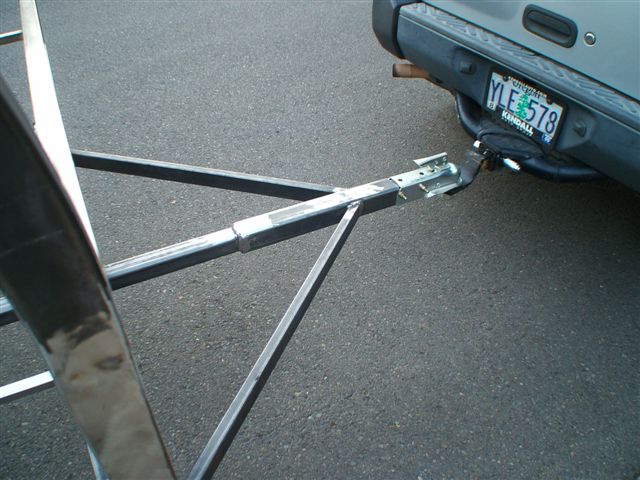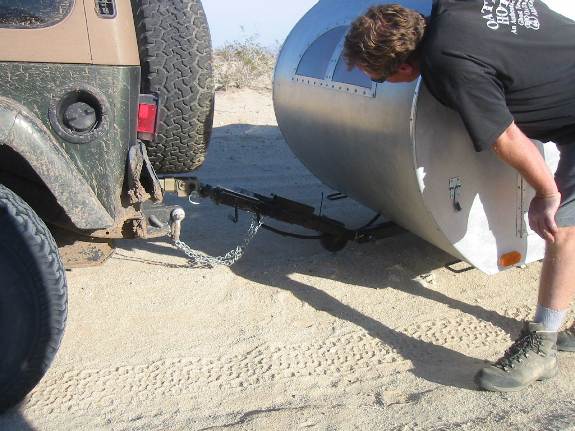Page 1 of 3
Vertical Hitch Pin??? Any thoughts???

Posted:
Sat Nov 08, 2008 12:11 pmby oregonguy
I am in the process of building "Skeletear". It has a removable/extendable tongue. My dad had the idea of doing a vertical hitch pin instead of a horizontal one, for increased security when leaving the trailer...The theiry being that somebody might have a tongue they could throw in there and tow it away, but probably not with a vertically oriented hitch pin. The other issue it would help with is that it would let me move my tongue jack further forward - hence closer to center, without it being in the way of the hitch pin.
Any thoughts? Any strong reason not to do it?
Thanks

[/img]
I'll be posting some updated pics in my album pretty soon...
Re: Vertical Hitch Pin??? Any thoughts???

Posted:
Sat Nov 08, 2008 2:59 pmby del
oregonguy wrote:I am in the process of building "Skeletear". It has a removable/extendable tongue. My dad had the idea of doing a vertical hitch pin instead of a horizontal one, for increased security when leaving the trailer...The theiry being that somebody might have a tongue they could throw in there and tow it away, but probably not with a vertically oriented hitch pin. The other issue it would help with is that it would let me move my tongue jack further forward - hence closer to center, without it being in the way of the hitch pin.
Any thoughts? Any strong reason not to do it?
Thanks

[/img]
I'll be posting some updated pics in my album pretty soon...
My opinion is freeing up the jack location is a good enough reason to go for it. The only down side I see is snagging something on the retaining pin from the bottom, and the pin being lost.
My 2c del

Posted:
Sat Nov 08, 2008 6:04 pmby oregonguy
ya I thought about the pin snag problem too....I'm pretty sure there are locking pins out there though that would be much less likely to get knocked out.

Posted:
Sat Nov 08, 2008 8:47 pmby Jiminsav
well, in my opinion, if you drill vertically through your tongue, you'll make the steel weaker in the axis where you want the most strength.

Posted:
Sun Nov 09, 2008 12:16 pmby oregonguy

Hmmm....you think so? It seems to me that the strength in the vertical axis would come primarily from the the vertical material - the side walls, not the top and bottom....I'm no structural engineer or anything, could be thinking about this wrong...
Anybody else want to chime in on this? I definitely don't want to significantly weaken the strength of my tongue by drilling out it's strength.

Posted:
Sun Nov 09, 2008 1:54 pmby Jiminsav
well, it's been a long time, but this might be relevant to the discussion.
Dave Nathanson wrote:Stick out your tongue and say "ahhhh" . 2"x2" square tube is nifty & all, but don't get all wimpy with the wall thickness! Mine was 1/8" and really needed to be more. And now I'm thinking that the outer tube should extend out longer, as Guy suggested to me. I'm sort of hashing it over now. If you *never* do anything more than putt along the street with light loads, properly balanced, then maybe the 1/8" wall will do. But it only takes once to smash it up quickly. Baja washboard road will do it!!! Just ask Larry Sorensen!
http://www.outbackteardrop.com/I still like the single tongue because it's not always in the way when I need to get into the back of the Jeep, but I'm going thicker next time. 1/8" is apparently ok for the frame, but the spot where all the forces come to bear needs to be a lot stronger! Oh, and if I did have a welded "A" frame tongue, it would have been much less likely that I could have made such a trail repair and been moving again so quickly. In my case I was able to substitute part of a Hi-lift jack and was on my way in 2 hours.


More photos on this here:
http://www.roughwheelers.com/montego/TD/BajaAdventure2004/index_4.html#PICT1849.html
Re: Vertical Hitch Pin??? Any thoughts???

Posted:
Sun Nov 09, 2008 2:01 pmby del
oregonguy wrote:
[/img]
I am no engineer, but I think this tongue (I think that is 1/4" walled tubing I am seeing) will pull a 3000 lbs (or less) tear with the diminished strength just fine. Consult Andrews tongue strength guide to be sure.
del

Posted:
Sun Nov 09, 2008 4:45 pmby Tx River Rat
I was in the steel business for a long time and you do get most of your stiffness from th side walls,if your worried about drilling a hole vertical brace it with a flat plate on the bottom side;
Most of the old farmer Brown trailers had vertical pin hitches and they pulled heavy loads.
Ron

Posted:
Sun Nov 09, 2008 4:54 pmby oregonguy
If I'm looking at that close up photo of the damage correctly, I think that hole is actually drilled in the horizontal axis....You can see the profile of the wheel of the tongue jack in the folded position. The camera angle makes it appear that you are looking down...because of where the ground appears....but I think we are actually looking at a horizontal hole....not absolutely positive of course, but pretty sure.
My main tongue is 1/4" steel 2"x2" and the side tubes are 1/8" steel 1"x2" - should be far more than strong enough.

Posted:
Sun Nov 09, 2008 6:57 pmby brian_bp
The most highly stressed parts of a square box beam under vertical load are certainly the top and bottom, not the sides. Holes can be drilled at mid-height through the side walls with little loss of strength... but if the design is marginal enough such a hole can still be the "last straw" leading to failure. I would certainly not drill a significant hole in the top or bottom of such a beam without adding reinforcement, such as the plate which Ron mentioned.
For an illustration of this, look at the frame rails of any modern truck: there are lots of holes through the sides, but virtually none through the top or bottom, whether the frame is a C-channel or fully boxed. Another example: look at an I-beam... the material is at the top and bottom where it is primarly needed, rather than the "web" in between which serves to keep top and bottom plates apart - and the web can be punched full of holes near the middle.
Also... is there a serious risk of someone carrying around a removable tongue to use to steal this trailer? If the trailer is that valuable and the thief that determined, they don't need a tongue at all to hook it up to a real tow truck and haul it away.

Posted:
Mon Nov 10, 2008 9:42 amby oregonguy
Wow, that's good info...ok...maybe I'll make a reinforcement plate on the bottom like Ron suggested, or maybe I'll just scrap the idea...The most appealing thing about it for me is the ability to move the tongue jack forward into the range I want it without the two items getting in each others way. Maybe I'll modify the hitch pin itself with a flat plate on the end or something very low profile like that so the clearance issue becomes less problematic.
It seems like having the hole towards the end of the material - where a hitch pin goes, would have a far lesser effect on strength than having a hole somewhere in the middle...?...Not to mention that inside of the female end of the tongue is a 17" long 1/4" 2"x2". doesn't that also add some stiffness and strength? It feels like I'm going overkill enough that 1 hole wouldn't be the end of the world...my target tongue weight is like 120# or so.
Regarding the theft resistance factor...sure it's not all that likely to get your trailer ripped off, removable tongue or not. This was just a side benefit that also gives one more reason to keep honest people honest. I understand that if somebody wants anything bad enough, they'll find a way to get it.

Posted:
Mon Nov 10, 2008 11:30 amby Sawyer
I'd say just tow that whole heap to the dump and toss it in the metal recycling bin... Save me the wheels and tires though. However, if you do decide to keep working on said heap, I (without any usable knowledge or experience on the subject) think you'll be more than fine.
To others: I've seen this tear at just about every stage of its progress, and it's so overbuilt, I see no way (short of a tree falling on the tongue) that this sucker is ever going to bend.
It's probably a good precaution to weld a plate on the bottom, but I think the vertical pin idea is as cool as the other side of the pillow. You might also want the top side of the pin to have some sort of rubber washer or grommet or something to keep excess water out of your frame.
PS, let me know when you want to come pick up that wire, I have 400' of green 12awg, and about 100' of black 16awg.

Posted:
Mon Nov 10, 2008 11:46 amby oregonguy
I've thought briefly about towing the whole thing to the dump once or twice during the process so far.

I don't think I am going to need that wire after all. I went to jerry's and got 8 gauge for the battery lead and I have tons of 16 gauge for the internall runs.
I got nearly all the wiring pulled this weekend, nearly all of it through the frame tubing, turned out great! Next major step is interior wall panels, then ceiling and floor, then insulation, so forth and so on.
Still vacillating on what to do about the whole hitch pin ordeal... oh well.

Posted:
Mon Nov 10, 2008 12:10 pmby starleen2
oregonguy wrote:Still vacillating on what to do about the whole hitch pin ordeal... oh well.
Go with your "gut" feeling about it and let us know how it turns out. Most of the very good ideas come from people who were willing to "risk it" and it worked for them. You can make anything break if you apply enough force - compression, teinsal strength, formulas, etc are good, but drill the hole and see where it takes you

Posted:
Mon Nov 10, 2008 12:38 pmby Arne
re veritcal hitch pin. The majority of strength comes from the top and bottom in most members. Think of an I beam.... I try to avoid drilling any holes in the top or bottom of any metal member on my trailers. That is where the problem might occur.
And if I do drill holes top/bottom, I try to keep them as small as possible. I would be reluctant to drill a hole that removes more than 20 pct of the surface.
 [/img]
[/img]
 Hmmm....you think so? It seems to me that the strength in the vertical axis would come primarily from the the vertical material - the side walls, not the top and bottom....I'm no structural engineer or anything, could be thinking about this wrong...
Hmmm....you think so? It seems to me that the strength in the vertical axis would come primarily from the the vertical material - the side walls, not the top and bottom....I'm no structural engineer or anything, could be thinking about this wrong...



